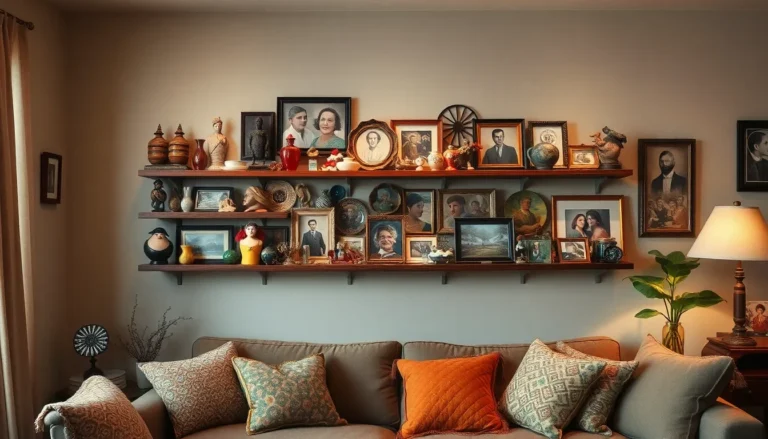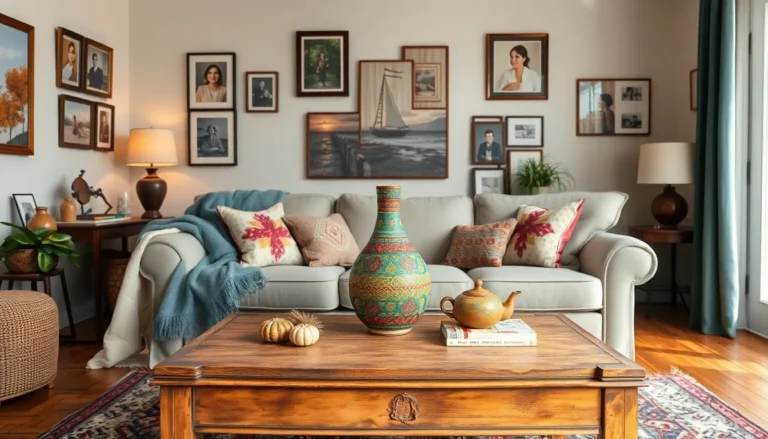Imagine walking into a room where everything feels just right. The furniture invites you in, the space flows seamlessly, and you can practically hear the walls whispering, “Stay a while!” Achieving that perfect room layout flow isn’t just about tossing furniture around like a game of Tetris; it’s an art form that can transform any space from drab to fab.
Table of Contents
ToggleUnderstanding Room Layout Flow
Room layout flow refers to the efficient arrangement of furniture and space that facilitates movement and interaction. This concept creates a functional and visually pleasing environment.
Definition of Room Layout Flow
Room layout flow encompasses how different areas within a space connect and interact with one another. It considers pathways, visual lines, and the placement of furniture to optimize the user’s experience. A thoughtful layout ensures that movement through the space feels natural and unobstructed. It emphasizes not just aesthetics but the practical use of space as well. Understanding this flow involves assessing dimensions and furniture scale to achieve balance and harmony.
Importance of Room Layout Flow
Room layout flow impacts both functionality and emotional responses. An effective layout promotes easy navigation, reducing frustration and enhancing usability. When furniture is arranged thoughtfully, it encourages social interaction and activity. In contrast, poor layout leads to chaos and discomfort. A well-planned flow also enhances the overall aesthetic appeal, making spaces more inviting and enjoyable. Prioritizing layout flow can significantly elevate a room’s atmosphere, ensuring it serves its intended purpose effectively. Striking the right balance in any space fosters a welcoming and harmonious environment.
Key Elements of Room Layout Flow

Room layout flow comprises several key elements that enhance how a space is experienced. Understanding these elements can significantly improve both functionality and aesthetic appeal.
Space Allocation
Space allocation determines how much area is designated for different functions. Effective use of space allows for comfortable movement and interaction. Zones for specific activities like dining, conversation, or relaxation must be clearly defined. Leaving adequate space for movement between these zones prevents congestion and enhances usability. Consider furniture size and arrangement to avoid overcrowding. Prioritization of space helps create a balanced atmosphere that encourages engagement.
Furniture Arrangement
Furniture arrangement plays a crucial role in achieving optimal room layout flow. Strategic placement of furniture fosters natural conversations and easy access to various areas. It’s essential to position seating for face-to-face interactions while considering views and natural light sources. Variations in height and scale add visual interest, while cohesive styles contribute to the overall ambiance. Prioritizing an inviting arrangement enhances the room’s functionality, making it more welcoming and comfortable.
Traffic Patterns
Traffic patterns guide movement throughout a space, affecting how easily individuals navigate. Creating clear pathways ensures no obstacles impede flow. Wide, unobstructed routes promote comfort and satisfaction, reducing frustration. Analyze how individuals traverse the room from one area to another. Well-defined traffic patterns contribute to a harmonious layout, making the space feel larger and more inviting. Prioritizing these patterns fosters a seamless experience, encouraging more interaction and engagement among occupants.
Tips for Optimizing Room Layout Flow
Optimizing room layout flow involves thoughtful strategies that enhance the usability and aesthetics of a space. Implement the following tips for a more inviting environment.
Assessing Your Space
Begin by measuring dimensions accurately. Knowing the size of the room helps determine what furniture fits without overcrowding. Identify natural features, like windows and doors, as they dictate traffic flow. Evaluate existing furniture to see whether it complements the intended layout. Consider how each area will be used, such as relaxing or entertaining, to ensure you allocate space effectively.
Choosing the Right Furniture
Select furniture that fits the scale of the room. Bulky pieces can hinder movement and make the space feel cramped. Opt for multi-functional items, like ottomans with storage, to maximize utility. Prioritize items that enhance social interactions, such as comfortable seating arranged in a conversational layout. Pay attention to color and texture, as these elements influence the overall atmosphere.
Creating Clear Pathways
Establish clear pathways for effortless movement throughout the room. Keep pathways at least 24 inches wide to prevent obstruction. Arrange furniture to create natural routes without blocking access to entrances or exits. Position larger pieces away from high-traffic areas, ensuring guests can navigate with ease. Lay down area rugs to visually define spaces while simultaneously guiding movement.
Common Mistakes to Avoid
Avoiding common mistakes helps achieve an effective room layout flow. Focus on recognizing these pitfalls.
Overcrowding the Space
Overcrowding a space disrupts its functionality. Many people underestimate the size of furniture needed for comfort and movement. Selecting pieces that are too large can lead to a cramped atmosphere, which negatively impacts usability. Instead, prioritize essential items that serve a purpose while leaving ample open areas. Maintain balanced spacing to create visually appealing environments. Aim for at least 30 inches between larger pieces for comfortable navigation.
Ignoring Traffic Flow
Ignoring traffic flow creates obstacles in a room. Clear pathways encourage free movement and interaction among occupants. Visual cues from furniture should naturally guide people through the space. A common guideline suggests pathways should be at least 24 inches wide, facilitating easy access to key areas. Without clear routes, individuals may feel confined and frustrated. Therefore, consider traffic patterns when positioning furniture, ensuring a smooth transition within different zones.
Neglecting Functionality
Neglecting functionality leads to an inefficient room layout. Prioritizing aesthetics over practical use often results in disappointment. Multi-functional furniture can enhance usability and adaptability in small spaces. It’s important to assess how each piece contributes to the overall purpose of the room. Spaces should not only look appealing but also serve their intended function effectively. Create designated areas for specific activities, ensuring that every element contributes positively to the layout’s flow.
Creating a room layout that flows seamlessly can transform a space into a welcoming haven. By thoughtfully considering furniture arrangement and traffic patterns, individuals can enhance both the functionality and aesthetic appeal of their rooms.
Prioritizing clear pathways and strategic space allocation not only promotes comfort but also encourages interaction among occupants. Avoiding common layout mistakes ensures that each element serves its purpose while contributing to an inviting atmosphere.
Ultimately, a well-planned room layout fosters an environment that balances practicality with beauty, making it essential for anyone looking to elevate their living spaces.



